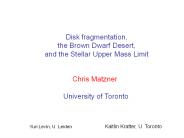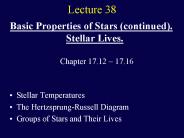Protostellar PowerPoint PPT Presentations
All Time
Recommended
Tracing Protostellar Evolution by Observations of Ices Adwin Boogert Geoff Blake Michiel Hogerheijde Caltech/OVRO Caltech/OVRO Univ. of Arizona Topics Introduction: a ...
| PowerPoint PPT presentation | free to download
The sonic point. Eliminate using: To get: Sonic point: both LHS and RHS vanish at ... through sonic point; putting u=cs and r=rc. gives C = -3. 'Breezes' ...
| PowerPoint PPT presentation | free to download
A MASSIVE PROTOSTELLAR DISK
| PowerPoint PPT presentation | free to download
Inverse P Cygni profile in H. low-density in circumstellar material ... Taurus & Upper Sco: ~3-5Myr. Orion: ~5Myr. TW Hydrae Association : ~10Myr. Oph. IC 2391: ...
| PowerPoint PPT presentation | free to view
gas/solid ratio increases (van Dishoeck et al. 1997) Detailed modelling gas phase mm-wave observations (van der Tak et al. 2000) Solid 13CO2: ...
| PowerPoint PPT presentation | free to download
Dust continuum emission peaks in FIR/submm out to z 5 ... BICE Galactic maps of CII at very low spectral resolution (top) and dust emission (bottom) ...
| PowerPoint PPT presentation | free to view
Convective turbulence (Lin & Papaloizou 1980, Ryu & Goodman 1992, ... Ampere's Law. Ohm's Law. Conservation of momentum. Disc Model. Vertical Stratification ...
| PowerPoint PPT presentation | free to view
The FWHM intensity contour of the 1200, 850, 450 m maps are very similar and ... The reduced chi-squared intensity profiles for a grid of models with varying ...
| PowerPoint PPT presentation | free to download
NH3 emission shows excellent (but not perfect) correspondence with dust continuum emission ... Tracing Dense Core Structure with NH3. NH3 (1,1) in Oph B ...
| PowerPoint PPT presentation | free to download
Turbulence needed to maintain pressure support for ... as a Route to Turbulence ... 'Turbulence is non-linear fluid motion resulting in the excitation ...
| PowerPoint PPT presentation | free to view
The little blue/red overlap in each lobe despite the jet lies close to the plane ... The inner jet (Blue 2, Red 2) does not show signs of velocity gradient. ...
| PowerPoint PPT presentation | free to view
Academia Sinica Institute of Astronomy and Astrophysics. ASIAA, Taiwan. Laurent Loinard ... Two cavities related with different ejection events (C1 older than C2) ...
| PowerPoint PPT presentation | free to download
... 5 M yr-1 (left, Palla & Stahler 1991) and 10-5 M yr-1 and 10-4 M yr-1 (right, ... Theoretically-computed birthline (heavy line) along with evolutionary tracks for ...
| PowerPoint PPT presentation | free to view
Recently X-ray emission from HH has been detected (Chandra and XMM-Newton) ... (XMM-Newton/EPIC-pn) Heavy jet: 1. M 10: too low LX ( 1028 erg/s) M 100: too ...
| PowerPoint PPT presentation | free to view
a) A flattened envelope is seen in C18O (J=2-1) (red image) surrounding the ... supported (accretion) disk is expected to form within the envelope at ~ 70 AU. ...
| PowerPoint PPT presentation | free to download
The innermost pair of knots are only at 500 AU away from the protostar. These knots likely trace the internal shocks in the jet produced by a periodical ...
| PowerPoint PPT presentation | free to download
National Aeronautics and Space Administration Protostellar Disks: Birth, Life and Death Neal Turner Jet Propulsion Laboratory ...
| PowerPoint PPT presentation | free to download
Examples: pre-stellar cores, protostellar envelopes, outflows, hot cores, protoplanetary disks... dust grains in the center of pre-stellar cores. Dust grain ...
| PowerPoint PPT presentation | free to view
Trillions of snowballs might be wandering around our galaxy, just like the Sun does. ... The Sun's protostellar disk probably extended far beyond Pluto, just ...
| PowerPoint PPT presentation | free to download
Massive star protostellar 'disk': resolved by VLA ... Stellar remnant graveyard. Effects of BH spin (precession) G.C. distance: Ro ( 1% unc. ...
| PowerPoint PPT presentation | free to download
Formation of protostar and protostellar nebula. Evolution of early sequences and ... Protostar starts sucking in nearby nebular gases, forms local increase in ...
| PowerPoint PPT presentation | free to download
IMF is a smooth function of mass, independent of time. ... the initial mass distribution of protostellar fragment masses, with fragments ...
| PowerPoint PPT presentation | free to view
1. The Sun began its life like all stars as an intersteller cloud. 2. This cloud collapses due to ... Schematic Illustration of protostellar disk-jet structure ...
| PowerPoint PPT presentation | free to view
Essentially ALL protostellar cloud magnetic flux must be lost during star ... collimation. Alfven surface. Accretion leads to ejection. dM/dt (wind) = 0.1 dM/dt (acc) ...
| PowerPoint PPT presentation | free to view
We present preliminary results of simulations of atomic and molecular ... Are extragalactic jets, stellar jets and protostellar jets connate? 100 km/s. 200 km/s ...
| PowerPoint PPT presentation | free to view
30.4 Gravitational collapse & early protostellar evolution I (H.B. ... cut out at least a decade of disk. size. Additional FIR excess ...
| PowerPoint PPT presentation | free to download
In an ongoing effort to identify and study high-mass protostellar candidates we ... This could be due to the fact that we have overestimated their dust temperature. ...
| PowerPoint PPT presentation | free to view
What are Herbig-Haro Objects? :45. A special type of open star clusters with very young stars. ... Galaxies with very active star formation. Protostellar disk ...
| PowerPoint PPT presentation | free to view
Space Infrared Telescope Facility. MW-90. August 2001. Protostellar Disks to Mature Planetary Systems (II) 10 My. 100 My. 5 Gy. Few My (Cores to Disks Team) ...
| PowerPoint PPT presentation | free to view
Title: PowerPoint Presentation Last modified by: Created Date: 1/1/1601 12:00:00 AM Document presentation format:
| PowerPoint PPT presentation | free to download
a radio interferometry located at ~4000m in Hawaii, with eight 6-m antennae. ... HD 161796: A Youngest PPN. At 17:44:55.43, 50:02:38.4 at 1 kpc ...
| PowerPoint PPT presentation | free to download
0 The Origin of the Solar System Planetary Orbits Neptune Uranus Saturn Jupiter Mars Earth Venus Mercury All planets in almost circular (elliptical) orbits around the ...
| PowerPoint PPT presentation | free to download
Title: PowerPoint Presentation Author: Chris McKee Last modified by: Chris McKee Created Date: 3/28/2005 11:27:07 PM Document presentation format
| PowerPoint PPT presentation | free to download
Outstanding Challenges of Massive Star Formation ... are found to be collimated with collimation factors 2-10 (Beuther 2002, 2003, 2004) ...
| PowerPoint PPT presentation | free to view
Collimation and pv-structure. Lee et al. 2001 ... Different degrees of collimation can be explained by different density ... Collimation is caused by Lorentz forces. ...
| PowerPoint PPT presentation | free to download
A Star is Born How Stars Are Formed Star formation in the Eagle Nebula as seen with the Hubble Space Telescope A tower of cold gas and dust rising from the Eagle ...
| PowerPoint PPT presentation | free to view
Title: Star formation - the accretion (luminosity) problem Author: Lee Hartmann Last modified by: Lee Hartmann Created Date: 6/6/1999 2:12:30 PM Document presentation ...
| PowerPoint PPT presentation | free to download
Avg density 1 grain/million m3. Whirlpool' Galaxy. Looking at a ... Supernova blast wave. Expanding emission nebula. Galactic density wave. p. 271. Molecular ...
| PowerPoint PPT presentation | free to download
Migration caused by a torques from interactions between planet and disk ... Mazeh T., 'Derivation of the mass distribution of extrasolar planets with MAXLIMA. ...
| PowerPoint PPT presentation | free to download
The Fundamental Problem in studying the stellar lifecycle We study the subjects of our research for a tiny fraction of its lifetime Sun s life expectancy ~ 10 ...
| PowerPoint PPT presentation | free to download
SIMBA. 37- channel hexagonal bolometer array. Central frequency of bandpass = 250 GHz (1.2mm) ... Observing with SEST/SIMBA. On-the-fly mapping. Scanning speed: ...
| PowerPoint PPT presentation | free to download
Fredrik Sch ier (Stockholm), Ewine van Dishoeck (Leiden), ... and the PROSAC team. ... Other species such as CH3OH may have their origin in the circumstellar disk...
| PowerPoint PPT presentation | free to view
Title: The Milky Way Author: Markus Boettcher Last modified by: roberts Created Date: 2/23/2003 4:28:17 AM Document presentation format: On-screen Show
| PowerPoint PPT presentation | free to download
Yuri Levin, U. Leiden Kaitlin Kratter, U. Toronto. Disk fragmentation in the main accretion phase ... Fragmentation is sensitive to the thermal evolution of ...
| PowerPoint PPT presentation | free to download
Star Formation. Giant Molecular Clouds. Visible. Infrared. Barnard 68. Star formation collapse of the cores of giant molecular clouds: Dark, cold, ...
| PowerPoint PPT presentation | free to view
... Class I: 70 3000 Ratio of Spitzer IRAC to submm emission F3.6/F850 0.003 A form of thermal ...
| PowerPoint PPT presentation | free to download
Optical Near-Infrared (1 3.5 m, COBE) Far Infrared (12 100 m, IRAS) Methanol Masers ... Science with Antarctic Infrared and Sub-millimetre Telescopes
| PowerPoint PPT presentation | free to download
M. Christensson, M. Hindmarsh, A. Bramdemburg: 2001, PRE 64, 056405 ... Christensson (2002 2005) H not exactly constant. Assume power law ...
| PowerPoint PPT presentation | free to view
Note that the following lectures include animations and PowerPoint effects such as fly ins and transitions that require you to be in PowerPoint's Slide Show mode
| PowerPoint PPT presentation | free to download
Surface temperature determines a star' color. The coolest stars are red, the hottest ones are blue. Only the brightest star colors can be recognized by the naked eye. ...
| PowerPoint PPT presentation | free to download
T Tauri stars, named after variable star T in Taurus are PMS stars that have ... For every star with mass 10-100 MSun, there are ~10 stars with 2-10 MSun, 50 ...
| PowerPoint PPT presentation | free to view
Elisabete M. de Gouveia Dal Pino (IAG-USP) Introduction ... Detailed model to determine HE (Melioli & de Gouveia Dal Pino, A&A, 2004) HE. SN. Shock wave ...
| PowerPoint PPT presentation | free to download
Where do stars, planets, we, come from?? From collapse of ... Spiral Galaxies. Disk in Center of Galaxy. Beta Pictoris. Lagoon. Nebula. Gaseous Pillars in M16 ...
| PowerPoint PPT presentation | free to download
Javier Ballesteros-Paredes1, Ralf Klessen2, Mordecai-Mark Mac Low3, Enrique Vazquez-Semadeni1 ... homogeneity & isotropy in a statistical sense; ...
| PowerPoint PPT presentation | free to download
Mark Wardle Macquarie University Sydney, Australia Protoplanetary disks Magnetic diffusion MRI with diffusion Ionisation equilibrium Live and Dead zones
| PowerPoint PPT presentation | free to download
0 Chapter 9 The Formation and Structure of Stars The space between the stars is not completely empty, but filled with very dilute gas and dust, producing some of the ...
| PowerPoint PPT presentation | free to download
























































